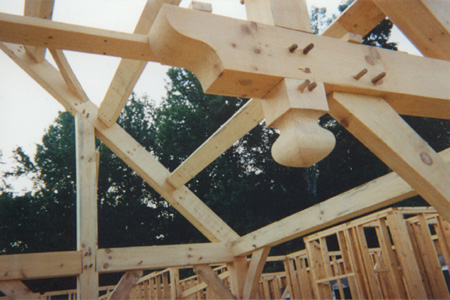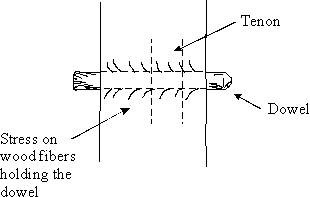Construction dowels used in Timber frame(pegs, pins, trunnels, and treenails)
Written by Michal Zajic
Abstract
This paper focuses on the fasteners in timber frame joinery — known as dowels, pegs, pins, trunnels, and treenails. These connections rely entirely on wood joinery and wooden dowels to resist load. The article discusses their material, cross-section, shape, and placement.
Introduction
Timber frame houses were common in early America and are enjoying renewed popularity today. The traditional timber frame is made of large sawn timbers (larger than 114 × 114 mm – 5" × 5") connected one to another by hand–fabricated joints, such as mortise and tenon. [1] Construction of such a frame involves rather sophisticated joinery, as illustrated below.
In the last ten years their popularity has increased, being widely used for residential living in the USA, Canada, and to some extent in United Kingdom and Germany.
This report highlights the significance and function of the fasteners in of timber frame joinery known as dowels, pegs, pins, trunnels, and treenails.
Hammer beam joint

Use of dowels
Dowels should not be used as a primary load-bearing member except in rare cases of dowels in which they are specially designed and sized for shear load (gambrel roof rafters). For the most part, these pegs behave like cotter pins, doing nothing other than holding joints together. The geometry of the joint should transfer all major forces to the timbers. Dowels are usually sized about 25 mm (1") in diameter.
Application
Pegs are driven into predrilled holes by blows from a mallet weighing from 6.8 to 9 kg (15 ~ 25 lb) [2]. When driving the peg in a friction develops between the timber and the peg, and this is what holds the pegs inside. There have been several different types of dowels developed towards increasing this frictional force.

Predrilled holes can be made in each timber separately during the fabrication in shop or on site when the joints are assembled.
Wood
Pegs should be made of a hardwood species, ideally white oak. Other hardwoods such as maple, locust, and red oak are also suitable.
Shape and size
There is no agreement among timber–framers or even engineers as to an ideal dowel shape, it is a manner of taste. The listing varies from neatly cut octagon to accurate shaved nominal round in cross-section.
Another pertinent issue is profile. While many experts recommend consistent diameter the throughout entire length, the others vote for tapers of various degrees. Either way, the dowels should be tapered at least at the very end in order to avoid peg splitting when hammering in.
Several frequently used shapes
- Well-turned, slightly oversized tapered dowels, cut and used when green, soaked in linseed oil

- Turned, oversized pegs, cut and used when dry

- "Squared", cut and used when dry

The length of dowels depends on timber sizes and basically should be several inches longer, such a practice is very helpful in case of splitting when the dowel is cut down and driven in again. The dowels can be can be trimmed flush or left whole.
Grains
It is strongly recommended to use dowels with a straight parallel grain. When using dowels with angled or twisted grains, they become weaker (check and split) when driven in.
A minor issue with regards to grain direction is the alignment of the grain between the dowel and pinned timbers. The dowel is a little stiffer with the annual rings aligned one way, but the shrinkage is greater in the same direction. [2]
Green or dried
There has always been a question of using green or dried wood for dowels, but the answer is not so easy, though. For the cutting and rising of a timber frame building is almost exclusively used green wood and dowels made of it are tough and usually do not check or split when being driven in. On the other hand they shrink and might become loose and fall out.
By contrast, dried dowels tend to crack when driven in and do not shrink. The more the adjacent wood shrinks, the greater frictional force holds the dowel in place.
Timber frame joinery and dowels placement
“Yet, experimental tests of all–wood joints have identified several failure mechanisms that are not currently formulated within the context of the yield theory. With suitable extension of the theory and identification of material parameters of the wood fasteners, the yield model approach can be used directly for design of joints in traditional timber frame buildings.” [3]
The difficulty arises when carpenter–style joints are used to transfer tension loads. In this case, the shear, bending, and dowel bearing strength are critical to the integrity of the joint. When the full strength requirements of the NDS (National design specification for Wood Construction, USA), ÈSN 73 17 01, and EC 5 are difficult to satisfy, two main concerns need to be addressed: the tenon end edge distance and cross-grain tension in the post.
References
- FOREST PRODUCT LABORATORY, Wood handbook, 1999, U.S. Department of Agriculture, Forest Service, Forest Production Laboratory
- BENSON, T.: Building the timber frame house, First Fireside Edition, 1995
- SCHMIDT, R. J.; MACKAY, R. B., LEU, B. L., Design of Joints in Traditional Timber Frame Buildings, University of Wyoming, Laramie, WY, USA
- CSN 73 17 01 . Navrhovanie drevenych stavebnych konstrukcii
- Eurocode5
